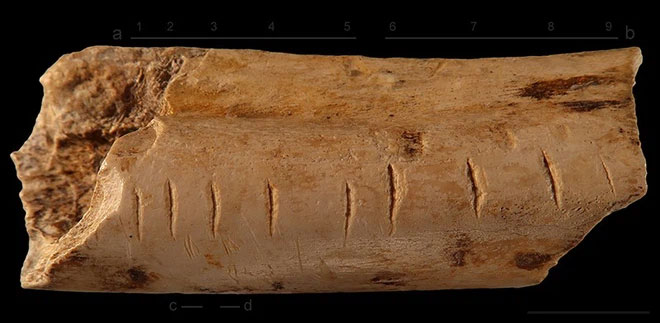About 60,000 years ago, in what is now the southwestern region of France, a Neanderthal picked up a piece of hyena thigh bone and a stone tool, then began to “craft.” When finished, the bone had 9 very similar and nearly parallel notches, as if they were indicating something.
Francesco d’Errico, an archaeologist at the University of Bordeaux, France, has examined many ancient carved artifacts throughout his career and believes that this hyena bone—found in the 1970s at the Les Pradelles site near Angoulême—is an unusual specimen. While ancient carved artifacts are often understood as works of art, this bone seems to serve multiple functions, D’Errico said.

The bone with 9 similar notches found at Les Pradelles.
D’Errico argues that it may represent information about counting. If his hypothesis is correct, then modern humans are not the only species that developed a numerical symbol system: Neanderthals may have done so as well.
“The origins of numbers remain a relatively vacant niche in scientific research. Researchers are not even consistent about what constitutes a number, although a 2017 study defined numbers as discrete entities with exact values represented by symbols such as words and signs,” said Russell Gray, an evolutionary biologist at the Max Planck Institute for Evolutionary Anthropology in Leipzig, Germany.
The origins of numbers are increasingly attracting attention as researchers from various fields explore it from different angles.
Cognitive scientists, anthropologists, and psychologists are examining contemporary cultures to understand the differences between existing numerical systems—where a numerical system is defined as the symbols a society uses for counting.
They hope to uncover hidden clues within modern systems that could help illuminate their origins. Meanwhile, archaeologists are searching for evidence of ancient numerical symbols through artifacts. These studies are helping to build the first detailed hypotheses about the development of numerical systems.
Numerical Instinct
Researchers once believed that humans were the only species capable of perceiving quantity, but findings from the mid-20th century revealed that many animal species also possess this ability. For instance, fish, bees, and newly hatched chicks can immediately recognize quantities up to four.
Some animal species also have the ability to “discriminate quantities”: they can perceive the difference between two quantities if the difference is sufficiently large. For example, they can distinguish a group of 10 from a group of 20 objects but cannot differentiate between 20 and 21 objects. Six-month-old infants also demonstrate a certain level of quantity recognition.
According to Andreas Nieder, a neuroscientist at the University of Tübingen, Germany, all of this suggests that humans also have an innate instinct for numbers, arising through evolutionary processes like natural selection, as this ability would provide adaptive advantages.
Rafael Núñez, a cognitive scientist at the University of California, San Diego, and one of the leaders of the Quantitative Understanding through the Development of Tools for Cognition (QUANTA) project, agrees that many animal species may have an innate ability to assess quantity.
However, Núñez argues that human cognition of numbers is often much more complex and cannot arise through a process like natural selection alone. Instead, many aspects of numbers, such as language and written symbols representing numbers, must be created through cultural evolution—a process by which individuals learn through imitation or being taught a specific skill.
While many animal species exhibit a certain level of cultural development, a culture related to counting is uniquely human. A few chimpanzees have been taught in captivity to use abstract symbols to represent quantities, but neither chimpanzees nor any other non-human species use these symbols in the wild.
According to Núñez, it is essential to distinguish between what he calls the innate perception of “quantity” seen in animals and the perception of “arithmetic” in humans.

The baboon bone marked with notches; researchers suggest this may be a form of primitive counting.
But not everyone agrees with Núñez. Nieder argues that neurological studies show clear similarities between how non-human animals process quantities in their brains and how the human brain processes quantities.
Nieder states that it is misguided to draw overly rigid boundaries between the two behaviors, although he agrees that human numerical ability is far more advanced than any other species: “No non-human species can use numerical symbols.”
D’Errico’s analysis of the bone with 9 notches at Les Pradelles may provide some insights into how the earliest stages of numerical systems formed. He studied the 9 notches under a microscope and noted that their shape, depth, and other details are similar enough that they seem to have all been created with the same stone tool and carved in the same manner.
This suggests that all 9 notches were made by an individual in a single crafting session, lasting a few minutes or hours.
However, D’Errico does not believe that this individual intended to produce decorative patterns, as the spacing between the notches is uneven—a common sign of decorative patterns on ancient artifacts. That observation—and the fact that the grooves were made in a single crafting session—led him to think that the notches on this specimen are a record of numerical information.
Signs of a Complex System
The bone at Les Pradelles is not the only discovery. In excavations at Border Cave in South Africa, archaeologists discovered a baboon bone approximately 42,000 years old also marked with notches. D’Errico suspects that modern humans living there at that time used the bone to record numerical information.
In this case, microscopic analysis shows 29 notches carved with four distinct tools and thus represent four different events recording numerical information, occurring on four separate occasions. Moreover, he states that discoveries over the past 20 years indicate that ancient humans began creating abstract carvings, suggesting sophisticated cognition, hundreds of thousands of years earlier than previously hypothesized.
Based on these discoveries, D’Errico has developed a scenario explaining the formation of numerical systems through the act of creating such artifacts. His hypothesis is one of two theories about the prehistoric origins of numbers published so far.
According to D’Errico, it all started by chance: ancient people accidentally left marks on bones when they butchered animals; later, they made a leap in awareness when they realized they could intentionally mark bones to create abstract symbols. Individual marks began to encode numerical information. He stated that the hyena bones at Les Pradelles could be the earliest known example of this type of marking.
D’Errico admits there are gaps in this scenario. It is unclear what cultural or social factors may have encouraged ancient people to start intentionally marking on bones or other artifacts. As one of the four principal researchers of the QUANTA project, D’Errico mentioned that the project will use data from anthropology, cognitive science, linguistics, and archaeology to better understand those social factors.
Alternative Interpretations
However, Núñez from the QUANTA project and several researchers not involved in this project warn that it is very challenging to accurately interpret ancient artifacts like the Les Pradelles bones. Karenleigh Overmann, a cognitive archaeologist at the University of Colorado, Colorado Springs, highlighted the difficulties through the example of information sticks used by Indigenous Australians.
These sticks, often long, flat, or cylindrical pieces of wood, are decorated with notches that appear to encode numerical information—but in reality, they do not.
Piers Kelly, a linguistic anthropologist at the University of New England, Armidale, Australia, agrees with Overmann’s perspective. Kelly noted that some information sticks are carved with tally-like marks but often serve as mnemonic devices to help the messenger recall details of the message they are sending. Kelly stated, “They are more like tools for recording a story than calculating a quantity.”
Wunyungar, an Indigenous Australian member of the Gooreng Gooreng and Wakka Wakka communities, mentioned that these sticks could convey different messages: “Some were used for trade—food, tools, or weapons. Others might carry messages of peace after war.”
Overmann has developed her own hypothesis about the evolution of numerical systems in prehistory. In a 2013 study, Overmann analyzed anthropological data related to 33 contemporary hunter-gatherer societies around the world.
She found that societies with simple numerical systems (with an upper limit not exceeding ‘4’) often had fewer material possessions, such as weapons, tools, or jewelry. In contrast, groups with more complex systems (with a much higher upper limit than ‘4’) consistently had more abundant resources. This evidence suggests to Overmann that societies with greater material wealth would develop more complex numerical systems.
Within societies that have complex numerical systems, there are still clues about how those systems developed. Overmann noted that such societies often use quinary (base 5), decimal (base 10), or vigesimal (base 20) numerical systems. This suggests that many numerical systems began with counting on fingers.

A hypothesis suggests that numerical systems developed from fingers.
Overmann argued that wealthier societies go beyond finger counting as they develop social needs for larger numerical systems: a society with more material wealth has a greater need to count (and count higher) to keep track of objects.
Recently, the QUANTA project received $11.9 million in funding from the European Research Council to begin testing various hypotheses about the origins of numerical systems. The aim of the project is to investigate when, why, and how numerical systems emerged and spread across the world. This project may even answer the question of whether numerical systems appeared exclusively in modern humans or if they also emerged in Neanderthals.





















































